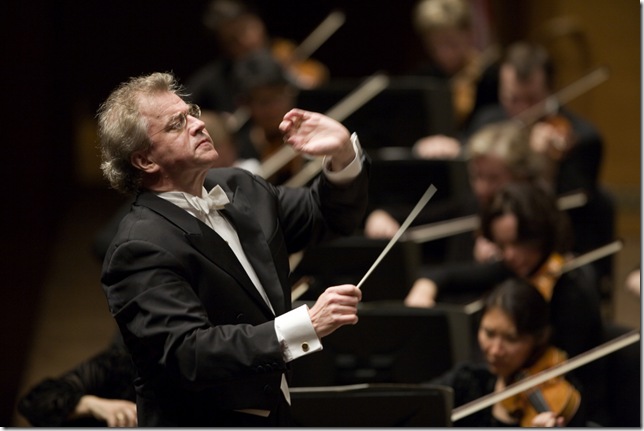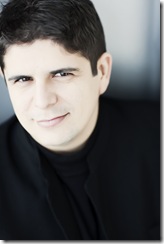By Lawrence Budmen
The New World Symphony’s concert on Saturday evening at Frank Gehry’s stunning New World Center looked fairly conventional on paper.
The standard repertoire pairing of a Chopin concerto and Sibelius symphony hardly seemed daring or innovative, unlike the Miami Beach-based orchestral academy’s more adventurous programming; yet the combination of the distinguished Finnish conductor Osmo Vänskä and the young Spanish pianist Javier Perianes made the concert special indeed, the artists delivering performances of the most insightful variety.
Perianes debuted with the New World two seasons ago and created so strong an impression among musicians and audiences alike that his reengagement was assured. His performance of Chopin’s Piano Concerto No. 1 in E minor (Op. 11) proved that the initial euphoria was totally deserved. Perianes processes virtuosity to burn. Chopin’s rapid runs, arpeggios and triplets were dispatched with flair and dazzling technique. What really distinguishes Perianes from the many gifted young pianists on the contemporary concert radar, however, is the depth and soulfulness of his playing. A true poet of the keyboard, Perianes is a born Chopin player.
At the piano’s initial entry in the opening Allegro maestoso, Perianes’ accents were bold and accretive, a command to sit up and take notice. The aristocratic grace and delicacy with which he shaped the second subject seemed to come from another pianistic sphere. At times, he seemed to be almost improvising the music, so personal was Perianes’ traversal of the familiar made new again. The lightness and sensitivity’s of Perianes’ touch turned the Romanze into an intimate reverie, the theme traced with exquisite subtlety.
In the Rondo finale, the lilt and pulse of the krakowiak, a Polish folk dance, streamed from the keys under Perianes’ masterful hands. Throughout the concerto, Perianes’ finely nuanced dynamics brought character and proportion to strophes too frequently played in matter-of-fact fashion. His final near fade to the softest pianissimo before the full throttle climax was an unexpected delight. The depth of expression and unaffected sincerity of Perianes’ playing set his Chopin apart from more conventional performances. A soft, caressing Chopin nocturne (No. 20 in C-sharp minor, Op. posth.) served as a discreet encore.
Chopin’s orchestrations of his two concertos and shorter piano-orchestral scores are often considered clumsy or mere window dressing to the dominant piano line but Vänskä did not treat them that way. The opening orchestral tutti emerged taut and stormy, truly romantic in spirit. He brought the orchestra’s silken strings down to a near whisper in the second movement before unleashing the New World’s full firepower in the finale.
Vänskä emphasized orchestral subtleties that often pass unnoticed in routine performances. In the finale, the clarity he brought to the bassoon line against the piano melody was but one of myriad instrumental details highlighted. Vänskä drew playing of heft and fervor from the ensemble. Clearly this was a performance to treasure, a freshly minted traversal of Chopin’s piano and orchestral writing.
From 2003 until last month, Vänskä was music director of the Minnesota Orchestra and was widely credited with restoring that ensemble’s luster after a decade of uneven performances, bringing the orchestra to new heights. He resigned his directorship Oct. 1 after a protracted contract dispute between players and management resulted in the musicians being locked out for over a year. (He has conducted members of the orchestra in concerts they have themselves produced and is scheduled to lead what has been dubbed “Musicians of the Minnesota Orchestra” in a gala reopening concert at the renovated Northrop Auditorium on the University of Minnesota campus in May.)
A frequent guest conductor of major American orchestras, Vänskä’s future American commitments remain uncertain due to the Minnesota situation. That made his New World Symphony appearance all the more significant. He is a conductor of major stature who inspires musicians to play at their best and brings enlivening freshness and strong musical values to every score he leads.
There has always been special magic when a Finnish conductor directs music by Jean Sibelius, Finland’s greatest composer. From Sibelius’s friend Robert Kajanus in the early 20th century to such later maestros as Jussi Jalas (the composer’s son in law) and Tauno Hannikainen (whose recordings of the Symphonies Nos. 2 and 5, the tone poem Tapiola and the Violin Concerto are among the finest Sibelius performances ever committed to disc), Finnish conductors bring a unique and heartfelt commitment to their countryman’s music.
Conductor and teacher Jorma Panula has trained a new generation of Sibelius specialists , including such stalwart maestros as Esa-Pekka Salonen, Jukka-Pekka Saraste and Sakari Oramo. Long considered one of Finland’s finest clarinetists, Vänskä is a graduate of the Panula conducting course and achieved international fame through his Sibelius recordings with the Lahti Symphony, at the time considered a provincial orchestra.
Vänskä’s performance of the popular Symphony No. 2 (in D major, Op. 43) was nothing short of a revelation. This was vigorous, old-school Sibelius in the manner of such past conductors as Eugene Ormandy and Serge Koussevitzky. He drew a rich, luminous tone from the string players and piercing power from the woodwinds. The burnished, rounded brass sound was a fulcrum for the entire performance. Four horns, three trumpets, three trombones and tuba produced wonderfully blended sonorities, brilliant but never harsh.
With a clear, no-frills baton technique, Vänskä turned the opening Allegretto into one intense dramatic crescendo, the granite-like climaxes perfectly judged. The pizzicatos on lower strings that open the second movement Andante, ma rubato were delineated with clarity while the pensive theme was given maximum impact at a measured tempo, the later reprise by a clarion trumpet heightening the relentless dramatic tension.
Vänskä’s highly charged reading of the Scherzo had a modernist edge, suggesting Sibelius and Stravinsky were not that far apart. The violins’ crisp articulation of rapid figurations at whirlwind pace was astounding. Vänskä achieved weighted contrast in the central section. Pealing brass fanfares heralded the memorable finale. The main broad, sweeping melody soared in the strings, the emotional undercurrent deep and volatile.
Vänskä’s splendidly terraced dynamics turned the repetitive march like theme into a series of ever more powerful buildups and decrescendos, the violas final affirmative statement of the subject in a major key like an unexpected burst of light from within the orchestra. Leading the coda at a stately pace, Vänskä brought a sense of monumentality to the triumphant final measures. The entire performance was superbly played, deeply felt and free of melodramatic exaggeration, and the chemistry between Vänskä and the young musicians was palpable, the players applauding him vociferously along with the audience.

